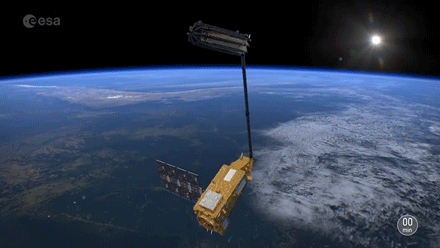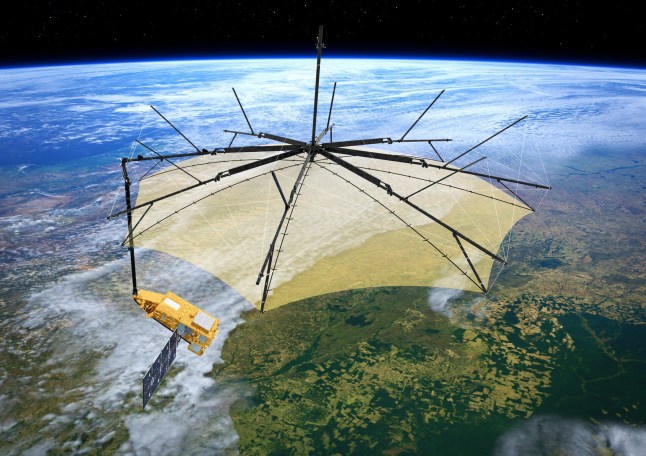
The ‘space brolly’ is nothing to do with geoengineering
A satellite that looks like a giant parasol was launched into orbit today,and will open itself up automatically in space.
The ‘space brolly’ was made by the European Space Agency,and blasted off this morning from South America.
While geoengineering projects about ‘dimming the sun’ have been in the news lately,this has nothing to do with them.
It’s not going to affect the weather,either by providing us with a cool bit of shade or by keeping the rain off (it’s much too high up for that).
The Biomass satellite is designed to ‘weigh’ forests using radar,to tell us more about the state of the world’s rainforests and jungles.
It will give ‘unprecedented insights’ into their ‘crucial role in Earth’s carbon cycle’,showing us more about how well they are faring.
Its 12-metre-wide mesh reflector (the umbrella bit) is supported by a 7.5-metre boom,and was developed by over 50 companies led by Airbus UK.
We’d better hope that it’s better than our own umbrellas when it comes to getting buffetted by space winds.
Forests absorb and store large amounts of carbon dioxide: around 8 billion tonnes every year.
This makes them important in regulating the planet’s temperature,and they are often called the world’s ‘green lungs’.
When they are cut down or degraded,this carbon is released back into the atmosphere,contributing to global heating.
We know this is a problem,but so far data is scarce on exactly how bad.
It is the first satellite to be equipped with a P-band synthetic aperture radar.
This is a type of radar which is often used to show us more about space,such as the surface of other planets,like Mars.

Are we sure they didn’t just repurpose the 02 Arena (Picture: ESA)
But now it’s being used to create detailed 3D maps of forests and essentially ‘weigh’ them to see how much biomass there is from trees (the total mass of living organisms in an ecosystem at a specific time).
The ESA say this is the first satellite which is ‘capable of penetrating forest canopies to measure woody biomass – trunks,branches,and stems – where most forest carbon is stored.
‘These measurements act as a proxy for carbon storage,the assessment of which is the mission’s primary goal.
‘Data from Biomass will significantly reduce uncertainties in carbon stock and flux estimates,including those related to land-use change,forest loss,and regrowth.’
The agency’s Director of Earth Observation Programmes,Simonetta Cheli,said: ”With Biomass,we are poised to gain vital new data on how much carbon is stored in the world’s forests,helping to fill key gaps in our knowledge of the carbon cycle and,ultimately,Earth’s climate system.’
Aug 18, 2025
URUMQI,China,March 17,2025--On March 14,State GridXinjiang Information &TelecommunicationCompany,leveraging the integration of party building and business operations as a platform,organized a &quo
Mar 18, 2025
TSX/NYSE/PSE:MFCSEHK: 945 Former Chief Actuary to Succeed PhilWitheringtonEffective May 9th TORONTO and HONG KONG,March 18,2025-- Manulife announced that Steve Finch has been appointed President and
Mar 18, 2025
SINGAPORE,March 3,2025--Alliance Manchester Business School (AMBS),the business faculty of the esteemed The University of Manchester,marked its 60th anniversary with a special celebration event for So
Mar 5, 2025